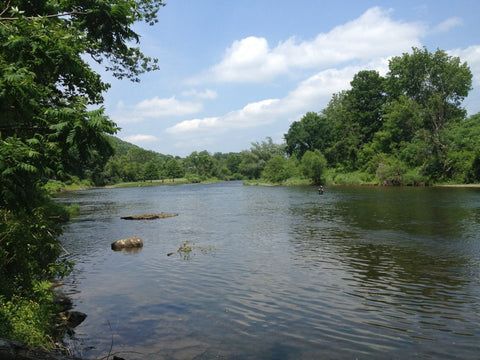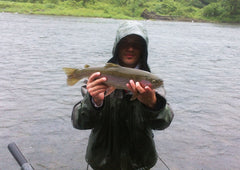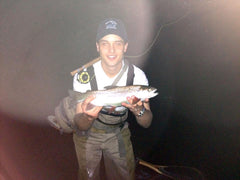2012 River Report Archive
East Branch of the Croton River, Brewster Ny
11/3/12 - 71 cfs - 46 degrees (Air Temp)
Our group of three went out mid day (3pm - 6pm) and started down river from Sodom Rd Bridge just below Phoebes Pool. We spent ample time at all of our go-to runs. No Luck. We fished streamers & tandem nymph rigs primarily. Water Clarity was 70% and all the runs looked really good. They certainly are HOLDING FISH.
*NOTE*: Lots of trees down along the trail, be prepared to take a detour or navigate over fallen trees & branches.
East Branch of the Croton River, Brewster Ny
9/30/12 - 63 cfs
The fishing has been (good /avg) for the last couple weeks. The rain recently has dropped water temps and the trout are looking for food. Nymphing will prove to be your best choice through most of the runs but trout can be found rising throughout the day (keep your eyes peeled). Approach these fish carefully and throw one of your smallest patterns drag free over their head and the trout will take care of the rest. Not Working?! Try extending your leader to 10' with smaller diameter tippet (28" - 36" of 7x). Always take a few minutes to fish your streamer through the pocket water and deeper slow moving pools. The big ones just need a reason the come off the bottom!
East Branch of the Croton River
8/25/12 - 58 cfs (low)
The fishing on the east branch has continued to be proven productive through the summer months. We spent a few hours in the evening yesterday working a few of our "go to" spots. There is significantly more water below the diverting reservoir than in weeks past although this water is warmer than above the Diverting Reservoir. (68-71 degrees) The temp on the upper east branch is ranging between 67-69 degrees. The water is lower than average and proper catch and release efforts are a must. There is some surface activity going on throughout the day - small midges and ants have been a popular choice. A majority of our time is spent working sub-surface, fishing bead head nymphs (sz16) with a wire dropper fly (sz20-22). This has always proven to be successful. The best fish was landed just at dark on a Rusty Moto Minnow Steamer on a dead drift.
East Branch of the Croton River
8/08/12 - 69 cfs (Low)
*Below Diverting Reservoir*
The dog days of summer are upon us, although that does not mean you cant get out Fly Fishing. We spent 3 hrs working the pocket water and deeper riffle runs w/ nymphs. There were some bugs hatching in the evening yet not enough to make us want to break stride and put on a dry fly. Our favorite rig is setting up with a copper john or bead head nymph (sz 14-16) anchor/lead fly with a dropper fly (chartreuse wire fly sz 20-22) about 12"-18" below you anchor fly. This rig has proven to be deadly throughout the entire Croton River System. I also will suggest using a large (sz 12 -14) White Wulff with a pheasant tail or wire fly nymph about 18" below as a dropper. This has proven to be a great method. Reports of trico is the morning have been common the last few weeks. (sz 20-22). Be sure to have a few staple midge/spinner patterns in your arsenal. We were able to land (6) trout a couple rainbows and healthy browns largest was 16.5". Don't be shy, use 7x and small flies (sz18-24)
West Branch of the Delaware River
7/16/12 - 530 cfs
A quick rainstorm bumped the river up on sunday but other than that it has been steady at around 540 cfs for the past few days. The fishing is getting increasingly difficult as the fish get harder to catch and the insect activity gets later and later and the hatches go on for shorter periods of times. The sulphur hatch is really great around 7-9 in the mid river areas and the trico hatch is very thick in the mornings if you know where to look. For the picky rising fish, try very sparsely and thinly tied sulphur patterns in 18-22, as well as some BWO's tied in the same manner as small as you feel comfortable fishing. There aren't too many tricks to catch these fish, you just have to time your cast and get lucky. Good luck!
Neversink River - Fallsburg NY Area
7/13/12 - 106 cfs
The Neversink river is running at a steady summer flow. The water temp is fluctuating between 58-62 degrees. This river may not have the largest fish on average but the scenery, accessibility and water temp can sure be a plus. Productive patterns right now will be your staple sulfur nymphs, pheasant tails, copper johns, hares ears & woolly buggers. The predominant dry fly activity has been in the late evening right before dark and early morning spinner falls. Fish your sulfurs, adams, rusty spinners, BWO's, and classic patterns like the grey fox & Blue Quills.
West Branch of The Delaware River
7/9/12 - 7/10/12 - 645-727 cfs
The Upper Delaware system is in full summer mode, where small flies and long leaders are a necessity. Sulphurs are hatching around noon until 2ish and then again from 7 to 9. Olives are important early and late in the day, and tricos are becoming a substantial hatch as the days go on. Anglers attention should focus on the river below deposit for the best Dorothea (small sulphur) water. Areas around dreamcatcher, rt17 pool and monument pool have good hatches. Deposit and Stilesville have all the pressure and the bugs are definitely waning, so spread out and find some fish that aren't so pressured (found and presented flies daily by other anglers . It is these un pressured fish that will make your day!
West Branch of The Croton River
6/21/12 - 13 cfs
Well, the west branch has returned to the unfortunate minute flow that more resembles a trickle rather than a tailwater. Hopefully someone will remember that there are fish in there and release some water, mostly we should just hope for rain. On a lighter note, the big fish are still there you just have to work for them. Nymphing where you can is productive, but when the flow gets this low, stalking rising fish in the slow frog water might be productive as well. Don't forget the 7X and size 28 midges if you plan on surface action because that will be the easiest way to raise fish.
West Branch of the Delaware River
6/21/12 - 892 cfs
It looks the water has been released some water.. hopefully this will keep the river cold for the next few weeks. if the flow is near what it is at the moment the large water release will definitely change the fishing. Hatches will start real early in the day and spinner falls will primarily occur at dusk after a hot day. Basically your main focus will be on sulphers, have all sorts of crazy sulpher patterns ready to try to fool picky fish. Sparse thorax patterns are still my favorite.Give Us a call and we will tie you up some of our favorite & "successful" patterns for your next trip.

West Branch of the Delaware River
6/10/12-6/12/12 - 575-625 cfs





West Branch of the Delaware River
6/3/12-6/5/12 - 650-700 cfs
The west branch was BOILING this weekend with fish eating sulfurs, olives, caddis and brown and yellow drakes. The rain and overcast along with the water being below 50 degrees kept the temperatures perfect for thick sulfur hatches. starting at around 1 or 2pm, the sulfurs were pouring out of the water in the upper river and anglers had more targets than they could ask for. Every square foot of the river had at least 10-20 sulfurs on it. The easiest time to catch these fish was the beginning and end of the hatch, when the bugs were thinner and the trout didn't have so many options to choose from. Riffles are also a great place to fish at these times where fish don't have as long to look at your fly and are caught easier. Try fishing larger flies like size 8-10 brown or yellow drakes to help your fly stand out in the bug soup. The spinner falls are also quite thick and fish in the slower pools are slurping everything. Remember that brown and yellow drake spinners often come back to the water with upright wings, so try fishing dun patterns during this time opposed to spent wing patterns. As the hatch progresses, the fish will get increasingly difficult to catch, so try using unconventional sulfur patters, like cripples and emergers instead of dun patterns to fool the fish.
West Branch of the Croton River
5/31/12 - 47 cfs
The water level has dropped back to a normal summer flow at the west branch, and the unbelievable nymphing that anglers, including the shop employees, have been taking advantage of for the past few weeks has definitely slowed. However, the hatches have not and the dry fly fishing is still spectacular. large fish in the 15-20+ inch range can still be seen actively surface feeding in the slower sections as well as smaller fish rising just about everywhere they can. These fish are moderately pressured and will take an accurate cast as well as 6X or maybe even 7X to get them to eat before you spook them. Small midges, Blue Winged Olives, Sulphers and terrestrial patterns can bring those finicky fish to the surface. Nymphing is still successful with small Midge pupa and Caddis pupa, but the large fish are not as stacked in the runs as they were in the weeks past. Recently I've been banging small size 8 Woolly Buggers at the bank in the upper section with great success, lots of chases and takes. With the high populations of fish in the upper section, the fish are eager to chase a fat meal before anyone else can get a hold of it. So if the action is slow don't forget to try a small streamer around runs and downed trees. You might be surprised at what comes venturing out of their deep lies.
East Branch of the Delaware
5/31/12 - 932 cfs at Fishs Eddy
The upper east remains at a good temperature, however the lower river is beginning to get warm and nearing the 70 degree mark. The recent rain has cooled down the Beaverkill which intern cooled the lower east but it will not last long. The upper east branch Green Drake hatch is beginning to dwindle, however Brown Drakes are starting to emerge. Isonychias are also are trickling throughout the day and large clouds of spinners can be found at dusk if you know where to look. Big and small Sulphers are emerging as well as Caddis but the fish seem to be focused mostly on Sulphers and Isos. At dusk, rising fish will eagerly take large drake spinners on thick tippet as long as your presentation is drag free. *Alert* Water temps are rising in the Lower East Branch, Main stem, Beaverkill and Willowemoc. When the temps reach 70 degrees, trout should not be targeted as they stand a poor chance of surviving.
West Branch of the Delaware River
5/29/12 - 600 cfs
The West Branch had surprisingly little pressure for this time for this of the year. 600 cfs is a great flow for both wading and floating. Sporadic risers can be found in most pools throughout the early parts of the day with steadier rising fish found after 2 or 3. The scattered thunderstorms induced small Blue Wing Olives as well as the larger Drunella Cornuta Blue Wing Olives emerging in the morning. There was also an abundance of Isonychias to accompany the Sulphers (both the large Ephemerella Invarias and small Ephemerella Dorotheas) and March Browns. Various Caddis including Blue Sedges, tan and brown caddis are also in the drift. Anglers should make sure their fly boxes include Sulphers in sizes 14-20 to cover both species, Isonychias in size 8-12, March Browns in size 12, Blue Wing Olives in size 14-20 to cover all the possible species of emerging olives, Black caddis patterns in size 14-16 for the Blue Sedges, and tan and brown caddis patterns in size 14-16. Keep in mind that the water in the lower West Branch is much warmer than the water at the top of the river, causing the bugs to hatch earlier in the day at the bottom of the river than at the top. So if you time it right you can start at the bottom of the river and fish the Sulpher hatch at its peak, then drive up the river to the top and wait for the Sulphers to begin to hatch when the water hits the right temperature.




